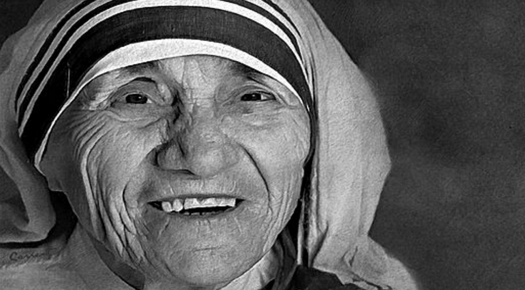
Mother Teresa has been declared a Catholic Saint after Pope Francis recently approved her second miracle, which was necessary for her canonization. Announcing her sainthood, the Vatican described Teresa’s life as ‘a metaphor for selfless devotion and holiness’. The Pontiff’s decision was welcomed by the Archbishop of Kolkata, who referred to it as ‘a real Christmas gift from the Vatican’.
Francis finalized his decision by signing a decree last week that states the inexplicable recovery of a 35-year-old Brazilian man after the Albanian nun’s intervention in 2008. The Brazilian man awoke from a coma that had been caused by a viral brain infection. A brief while before he was due for surgery, the man sat up speaking normally and seemed to be cured. A day later, he was declared entirely healthy.
Teresa, who was 87 at the time of her death in 1997, was revered as the ‘Saint of the Gutters’. She was awarded the Nobel Peace Prize in 1979 for dedicating her entire life to the service of the poor and needy in Kolkata (formerly known as Calcutta). In 2003, Pope John Paul II beatified Teresa after acknowledging her first miracle, where she helped cure a woman’s brain tumor after the woman approached her with prayers. The Vatican explains that one miracle qualifies a person for beatification (recognition of his or her entrance into heaven) while sainthood requires two.
By the time she died, Mother Teresa’s Missionaries of Charity, based in India, ran hundreds of orphanages, homeless shelters, clinics and soup kitchens. The Missionaries of Charity supported at least 4,000 nuns around the world. Her canonization is expected to take place in September 2016 and it is likely to be one of the main events of the Vatican’s Year of Mercy.
“It is a real Christmas gift that the Holy Father has given, especially the Church in (Kolkata),” said Archbishop Thomas D’Souza, Kolkata’s Archbishop. “We were waiting for this moment, since many years really, and now that it has come we are very happy, overjoyed.”
Francis, also a saint who prioritizes on reaching out to the poor, met with Teresa more than two decades ago while he was still serving as Archbishop Jorge Mario Bergoglio in Buenos Aires, Argentina. After the meeting, he spoke of how much he admired her ministry as well as her fearlessness in voicing the sentiments of those deemed as society’s outcasts.
“I would have been afraid to have had her as my superior, since she was so tough,” he said jokingly.
Teresa was born Agnes Gonxha Bojaxhiu in Skopje on August 26, 1910 into an ethnic Albanian family, in what is currently recognized as the Republic of Macedonia –but was then part of the Ottoman Empire. She joined the Loreto Order of Nuns in 1928, before deciding to found the Missionaries of Charity while traveling by train from Kolkata to Darjeeling in 1946. The order was established four years later and has since opened more than 130 houses worldwide that offer comfort and care to the needy.
Even though her charitable work has received widespread recognition, Teresa was not loved by all. She was often criticized for offering poor quality care and service to the underprivileged and accepting donations from shamed American financier Charles Keating and Haitian dictator Jean-Claude Duvalier. She was known for vociferously opposing the use of birth control measures as well as abortion, a policy that is in complete sync with the Vatican’s teachings; but detractors believe is an irresponsible idea, given India’s population problem.
Australian feminist and writer Germaine Greer described Teresa as a religious imperialist who wanted to convert people to Catholicism; while British atheist, author and polemicist Christopher Hitchens called her a fanatic and zealot, who accepted money from dubious sources like Keating and Duvalier.
To further explain the process of canonization, here is a look at the Vatican’s path to becoming saint:
Step 1: Examining the life of a candidate who qualifies for sainthood
Five years must pass after the candidate’s death before his or her examination is started, though the pope has the authority to dispense this waiting period. A bishop carries out the initial examination of the candidate’s life, assigning the designation ‘Servant of God’ if deemed worthy by the Vatican.
In 2003, Pope John Paul II fast tracked Teresa’s possible sainthood by allowing her beatification to start within two years of her death.
Step 2: Proving the candidate’s virtues
A church official directs this process, serving as the candidate’s advocate and proving that he or she once lived with heroic virtues. On completion of the examination, the documents are handed over to the Congregation for the Causes of Saints in Rome. Once approved, the candidate earns the designation ‘Venerable’.
In Teresa’s case, the official looked at various aspects of her character; including her strength of convictions, unity, courage, humility, forgiveness, knowledge and social justice.
Step 3: First miracle
For the beatification of a venerable individual, at least one miracle must be acknowledged after necessary canonical examination. After this step, the candidate receives the designation ‘Blessed’.
In 2003, the Vatican recognized the healing miracle of an Indian woman after she prayed to Teresa, following which she was soon rid of her brain tumours.
Step 4: Second miracle
For the canonization of a candidate, he or she must be responsible for a second miracle, though the pope has the authority to waive these requirements. Once the second miracle has been confirmed, the pope designates the candidate with the title of ‘Saint’.
Photo Credits: The Catholic Foodie
